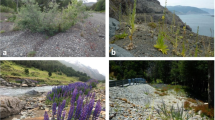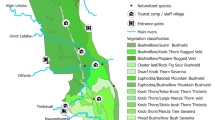Abstract
It is widely known that disturbed areas favour plant species invasion. However, the presence and impacts of introduced plants at rubbish dumps and landfills are less clear. We conducted a literature review to evaluate current knowledge on introduced plants species at these sites to assess their potential role as invasion epicentres. Most of the studies we found (91%) were observational and only described plant species presence in multiple landscapes, including rubbish dumps or landfills. A minority of studies (< 20%) specifically focused on plant species at these sites but did not evaluate their potential as invasion epicentres. The 215 introduced plant species belonging to 57 families recorded at rubbish dumps or landfills underestimates true numbers given that most studies do not report the full list of species. Most species are invasive (> 95%) and included in the Global Invasive Species Database or the DAISIE list. One species, Arundo donax, is among the 100 worst invasive species in the world and eight more are listed among the 100 worst invasive species in Europe. Invasive species present at these sites may alter fire regimens, produce toxic and allergen effects, outcompete native species, act as agricultural pests, and lead to economic losses. Our results are a first step to include rubbish dumps and landfills in the agenda of ecologists and managers that study invasive species, especially since compost from these sites are now being used in agricultural practices, thus possibly spreading invasive species propagules to distant locations.



Similar content being viewed by others
References
Andersen JK, Boldrin A, Christensen TH, Scheutz C (2010) Mass balances and life-cycle inventory for a garden waste windrow composting plant (Aarhus, Denmark). Waste Manag Res 28:1010–1020
Barnswell KD, Dwyer DF (2007) Vascular flora of the King Road Landfill in Northwest Ohio. Ohio J Sci 107:91–103
Brooks ML, D’antonio CM, Richardson DM, Grace JB, Keeley JE, Di Tomaso JM, Hobbs RJ, Pellant M, Pike D (2004) Effects of invasive alien plants on fire regimes. Bioscience 54:677–688
Ciesielczuk J, Czylok A, Fabiańska MJ, Misz-Kennan M (2015) Plant occurrence on burning coal waste—a case study from the Katowice-Welnowiec dump, Poland. Environ Socio-Econ Stud 3:1–10
Cortinovis C, Caloni F (2013) Epidemiology of intoxication of domestic animals by plants in Europe. Vet J 197:163–168
D’Antonio CM, Vitousek PM (1992) Biological invasions by exotic grasses, the grass/fire cycle, and global change. Annu Rev EcolSyst 23:63–87
DAISIE European Invasive Alien Species Gateway. http://www.europe-aliens.org/. Accessed July 2017
Del Río M, Font R, Almela C et al (2002) Heavy metals and arsenic uptake by wild vegetation in the Guadiamar river area after the toxic spill of the Aznalcóllar mine. J Biotechnol 98:125–137
Global Invasive Species Database. www.issg.org.database. Accessed July 2017
Grundy AC, Green JM, Lennartsson M (1998) The effect of temperature on the viability of weed seeds in compost. Compos Sci Util 6:26–33
Gurusiddaiah S, Gealy DR, Kennedy AC, Ogg AG (1994) Isolation and characterization of metabolites from Pseudomonas fluorescens-D7 for control of downy brome (Bromus tectorum). Weed Sci 42:492–501
Hobbs RJ, Huenneke LF (1992) Disturbance, diversity, and invasion: implications for conservation. Conserv Biol 6:324–337
Hoornweg D, Bhada-Tata P (2012) What a waste: a global review of solid waste management. Urban Dev Ser Knowl Pap 15:1–98
Hoornweg D, Bhada-Tata P, Kennedy C et al (2013) Waste production must peak this century. Nature 502:615–617
Judd WS, Campbell CS, Kellogg EA, Steven PF (1999) Plant systematics: a phylogenetic approach. Sinauer Associates, Sunderland
Kim KD, Lee EJ (2005) Soil seed bank of the waste landfills in South Korea. Plant Soil 271:109–121
Lake JC, Leishman MR (2004) Invasion success of exotic plants in natural ecosystems: the role of disturbance, plant attributes and freedom from herbivores. Biol Conserv 117:215–226
Oro D, Genovart M, Tavecchia G, Fowler MS, Martínez-Abraín A (2013) Ecological and evolutionary implications of food subsidies from humans. Ecol Lett 16:1501–1514
Pietsch M (2005) Soil and biowaste as potential pathways for invasive alien species, and regulatory approaches to minimize the risks. In: Alford DV, Backhaus GF (eds) Symposium proceedings no. 81: Plant protection and plant health in Europe: introduction and spread of invasive species. Humboldt University, Berlin
Pimentel D, Zuniga R, Morrison D (2005) Update on the environmental and economic costs associated with alien-invasive species in the United States. Ecol Econ 52:273–288
Plaza P, Lambertucci S (2017) How are garbage dumps impacting vertebrate demography, health and conservation. Glob Ecol Conserv 12:9–20
Pyšek A, PyšEk P, Jarošík V, HájeKM Wild J (2003) Diversity of native and alien plant species on rubbish dumps: effects of dump age, environmental factors and toxicity. Divers Distrib 9:177–189
Rahman ML, Tarrant S, McCollin D, Ollerton J (2013) Plant community composition and attributes reveal conservation implications for newly created grassland on capped landfill sites. J Nat Conserv 21:198–205
Randall RP (2016) Global compendium of weeds (online version). http://www.hear.org/gcw/. Accessed July 2017
Richardson DM, Pyšek P, Rejmanek M et al (2000) Naturalization and invasion of alien plants: concepts and definitions. Divers Distrib 6:93–107
Speziale KL, Lambertucci SA, Carrete M, Tella JL (2012) Dealing with non-native species: what makes the difference in South America? Biol Invasions 14:1609–1621
Thiele J, Otte A (2007) Impact of Heracleum mantegazzianum on invaded vegetation and human activities. Ecol Manag Giant Hogweed 2007:144–156
West PC, Gerber JS, Engstrom PM et al (2014) Leverage points for improving global food security and the environment. Science 345:325–328
Acknowledgements
We thank CONICET PIP00758 for financial support. Two anonymous reviewers, Laura Meyerson, Sarah Young and Fernando Ballejo helped us improve a previous version of this manuscript.
Author information
Authors and Affiliations
Corresponding author
Electronic supplementary material
Below is the link to the electronic supplementary material.
Rights and permissions
About this article
Cite this article
Plaza, P.I., Speziale, K.L. & Lambertucci, S.A. Rubbish dumps as invasive plant epicentres. Biol Invasions 20, 2277–2283 (2018). https://doi.org/10.1007/s10530-018-1708-1
Received:
Accepted:
Published:
Issue Date:
DOI: https://doi.org/10.1007/s10530-018-1708-1




